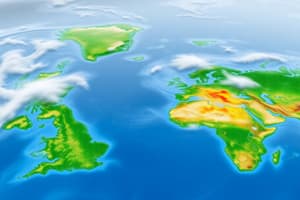Podcast
Questions and Answers
A weather map shows a line with semicircles on one side and triangles on the other. What type of front does this line represent, and what are the typical weather conditions associated with its passage?
A weather map shows a line with semicircles on one side and triangles on the other. What type of front does this line represent, and what are the typical weather conditions associated with its passage?
This line represents a stationary front. Weather conditions typically include prolonged periods of precipitation or cloudiness.
A weather map displays closely spaced isobars in a particular region. What does this indicate about the wind speed in that area, and why?
A weather map displays closely spaced isobars in a particular region. What does this indicate about the wind speed in that area, and why?
Closely spaced isobars indicate a high wind speed because they represent a large pressure gradient force.
A weather map uses sky cover symbols to indicate that a location is three-quarters filled. What does this indicate about the cloud cover at that location?
A weather map uses sky cover symbols to indicate that a location is three-quarters filled. What does this indicate about the cloud cover at that location?
This indicates that the location is experiencing approximately 75% cloud cover.
A weather map shows a 'T' symbol with the bar pointing in a specific direction. What information does this symbol convey, and what meteorological element does it represent?
A weather map shows a 'T' symbol with the bar pointing in a specific direction. What information does this symbol convey, and what meteorological element does it represent?
A weather map depicts alternating blue triangles and red semicircles on the same side of a line. What kind of front does this represent and how does it form?
A weather map depicts alternating blue triangles and red semicircles on the same side of a line. What kind of front does this represent and how does it form?
Flashcards
Weather Map
Weather Map
A graphical representation showing atmospheric conditions at a specific time.
Weather Symbols
Weather Symbols
Icons used on weather maps to represent different weather conditions.
Interpreting Weather Maps
Interpreting Weather Maps
Analyzing the symbols and data presented to understand weather forecasts.
Cold Front
Cold Front
Signup and view all the flashcards
High Pressure System
High Pressure System
Signup and view all the flashcards
Study Notes
Weather Maps
-
Weather maps are visual representations of atmospheric conditions at a particular time. They depict temperature, pressure, precipitation, wind direction and speed, and cloud cover.
-
Different symbols are used to convey specific types of weather data.
Interpreting Weather Maps Using Weather Symbols
-
Understanding Temperature Symbols: Different colors or shades on a map indicate varying temperatures. Key will usually display the range associated with each color. A specific symbol (possibly a thermometer) could be used to highlight the temperature of a particular area. Crucially, these symbols are essential for comparing temperature differences across regions.
-
Pressure Systems: High-pressure systems are often denoted by an "H" and are typically associated with fair weather. Low-pressure systems, represented by an "L", can indicate cloudiness, precipitation, and stormy conditions. The intensity of the pressure system is often indicated by the size of the symbol or shading.
-
Precipitation Symbols: Symbols representing types of precipitation (rain, snow, sleet, hail) can vary. Rain is often depicted by a symbol like a rain cloud. Variations, such as intensity (light or heavy rain), are often communicated via shading or line thickness. Snow is frequently indicated by a stylized snowflake. The amount and intensity of precipitation are reflected in the intensity of the symbols.
-
Wind Direction and Speed: Wind direction is often shown with an arrow indicating the direction of movement within a defined area. The length of the arrow (or a wind barb) corresponds to the speed of the wind. Wind vectors often provide a succinct representation of wind patterns.
-
Cloud Cover: Various cloud cover symbols (cirrus, cumulus, stratus) indicate the amount of cloudiness in a given area. The density and type of shading or patterning associated with these symbols helps to further define the nature of the cloud cover. A clear sky will be symbolised by the absence of any clouds.
-
Fronts: Fronts, such as cold fronts or warm fronts, are depicted on weather maps with color, lines, and arrows. These illustrate sharp changes in temperature and moisture. Symbols denote the type of front (cold, warm, stationary, occluded). The direction of the front movement is included.
-
Identifying Key Features: Weather maps include location information (latitude & longitude, cities). The careful interpretation of location within a weather map is essential for regional analysis.
-
Time Sensitivity: Weather maps are snapshots in time. To understand weather changes, several consecutive maps are needed. To note that trends or patterns of weather progression over time are crucial for forecasting and understanding the dynamics of a weather system. Therefore, interpreting symbols within a given timeframe is important.
Studying That Suits You
Use AI to generate personalized quizzes and flashcards to suit your learning preferences.




